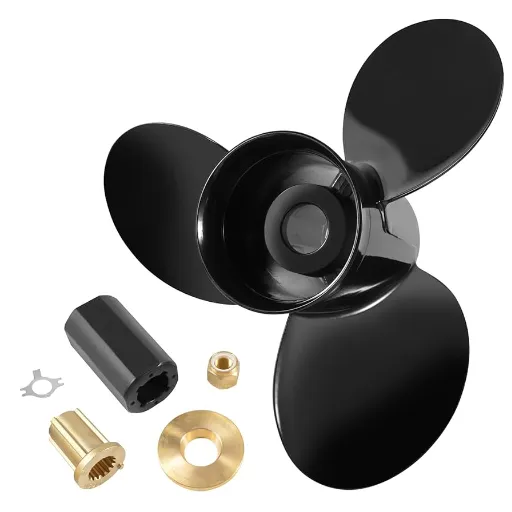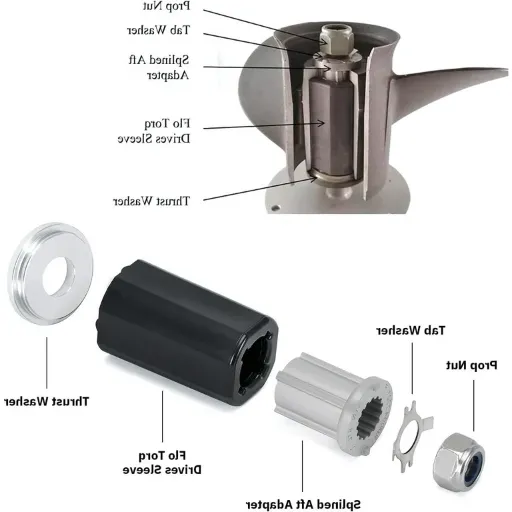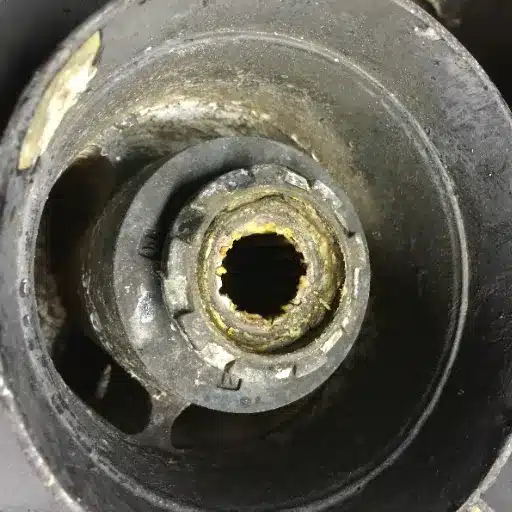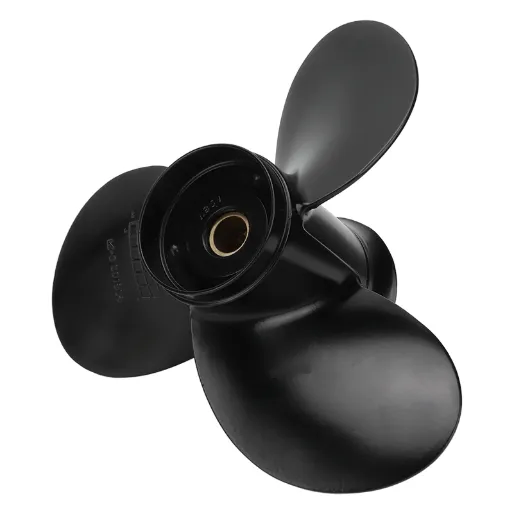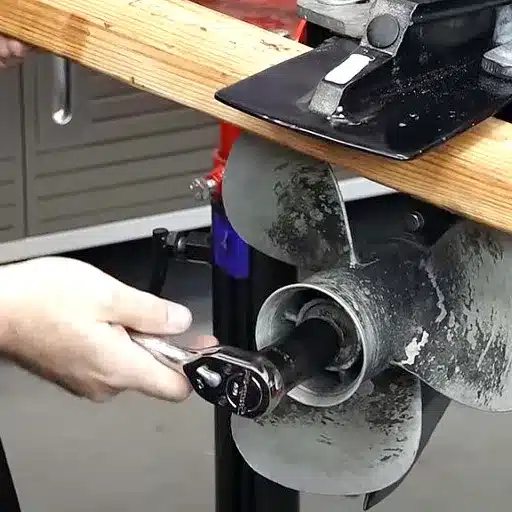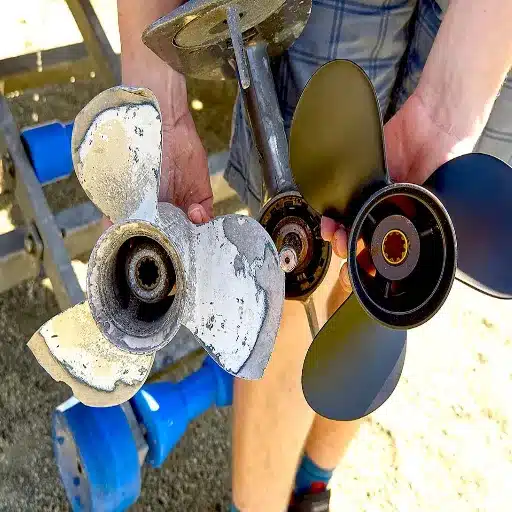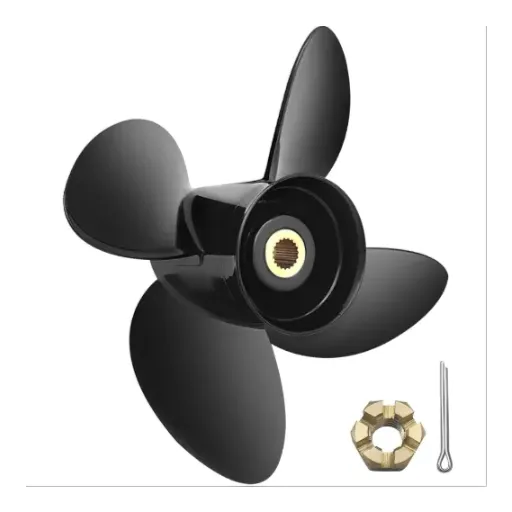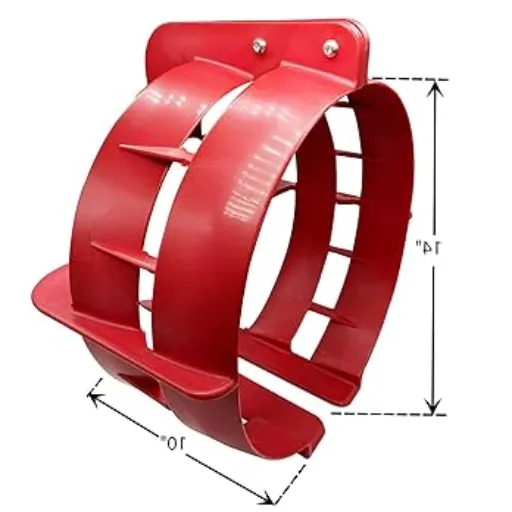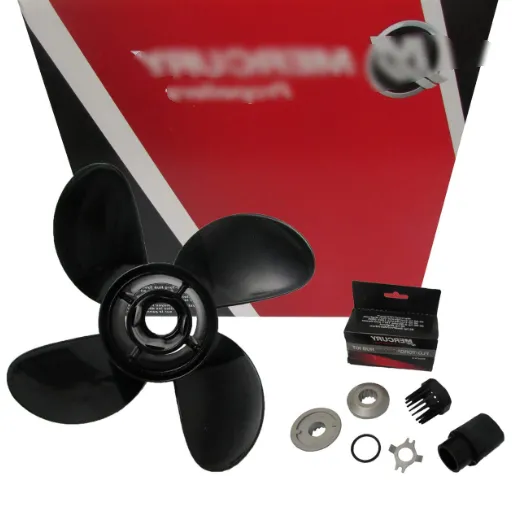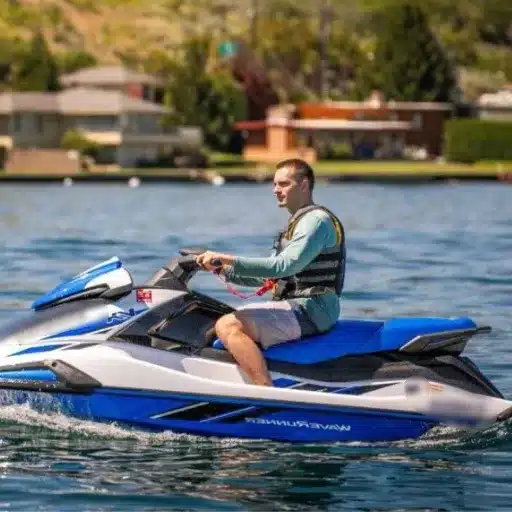Out in the open waters, few problems can carry as much frustration or pose as high a threat as the spinning of a propeller. Simple as the matter may sound, it sometimes threatens the smooth enjoyment of boating. Thus, potential boating accidents or situations in which one is rendered incapable of moving the vessel arise. Learning to identify a spun propeller, troubleshooting it, and fixing it will keep both the propeller and the boat safe and in working order. This is a comprehensive guide for 2025, designed to help you understand the issue, explore potential solutions, and take preventive measures. Whether you are an established captain or a recreational boater, this article delivers clear and concise information on keeping you prepared so that your ocean adventures remain smooth and safe.
Understanding Spun Propeller Basics
What Is a Spun Propeller?
A spun-propeller incidence occurs when the inner rubber hub of a propeller becomes separated from or loses adherence to the outer metal hub. It commonly occurs due to undue stress, environmental wear, or impact, rendering the propeller incapable of efficiently transferring the engine’s power to the water. Instead of the propeller blades gripping water and moving it ahead to build thrust, the engine revolutions increase with very little or no thrust being produced—a condition commonly known as spinning out.
Modern propellers are fitted with rubber hubs to prevent impacts, including hits on submerged objects, from causing shock loads and damaging the drivetrain. Over time, however, and more so in improper maintenance or under heavy loads, the rubber can degrade or be compromised. In such cases, the hub fails to maintain a secure bond, thus rendering erratic speed or complete blockage in the drive. Symptoms of a spun propeller include an immediate decrease in boat speed, even though the propeller is still turning at full engine RPM, or difficulty in achieving higher speeds.
A spun propeller may require the repair or replacement of the propeller hub, depending on whether it is severely damaged or only slightly damaged. It is advisable to inspect the propeller and its working components whenever possible to prevent this issue; this will make your vessel safer and more efficient.
Performance of Propeller Hub
This describes the transmission of power from the engine to the propeller blades by the propeller hub in moving vessels. As the major component of the propeller assembly, the hub absorbs and manages the torque generated by the engine, allowing for efficient thrust production. Hence, torque generation is minimized by the hub as much as possible to allow for minimal slippage between the engine and propeller. An efficient propeller hub results in optimum fuel consumption; otherwise, the engine runs at higher torque.p
In other words, many factors influence propeller hub performances, including materials, construction, and matching to the engine and propeller setup. Most of the present-day hubs are designed with a flexible or rubber insert that absorbs vibration, reducing wear on the engine and other drivetrain components. Meanwhile, harsh marine operating conditions, whether through saltwater corrosion or mechanical stresses, could wear down the material of the hub with time. Thus, regular maintenance is necessary, including inspection of the hub for wear or cracks that could lead to operational problems, such as efficiency loss or outright system failures.
By understanding how a prop hub functions and its importance, vessel operators will be better equipped to make informed decisions about replacements or upgrades, ensuring the propellers’ performance and reliability under varying operating conditions.
How Spun Props Affect Boat Stability
A spun prop is detrimental to the stability of a given boat, as it loses the ability to achieve efficient propulsion and maneuvering. When the inner hub of a propeller becomes worn or damaged, there is a corresponding reduction in the transfer of engine power to the propeller blades. The vessel loses thrust, hence losing speed, and tends to act sluggishly to inputs on the steering column.
⚠️ Important Safety Note:
The mutually opposed forces created by the spinning or malfunctioning propeller cause erratic motion, which is undesirable for stability, erratic or unsafe in many cases, in rough waters. Even such vessels, when reduced in efficiency by perhaps 10-15%, can prove to bring ample instability during sharp turns or high-speed operations, according to studies.
They also increase drag, making it challenging to maintain a straight line path while consuming more fuel.
This type of maintenance requires a thorough inspection and eventual replacement of an eroded propeller, if it is a spun propeller, as well as continuous maintenance of the surrounding drivetrain components to prevent operational inconsistencies. Upon restoration of the propeller system, operators can constantly maintain and ensure the stability, safety, and optimum performance of the vessel.
Common Causes of a Spun Prop
Wear and Tear by Regular Use
Considered over a long period, consistent exposure to huge rotational forces, water pressure, and environmental elements like salt corrosion tends to erode propeller hub integrity slowly. The rubber bushing in the hub absorbs vibrations and allows for a smooth transfer of power, but during operation, heat buildup due to friction and mechanical stress may cause deterioration. Henceforth, the deterioration lessens the bond between a propeller hub and its shaft, a situation that essentially increases the likelihood of slipping under load.
Furthermore, repeated impacts with submerged debris or slight groundings increase wear effects and, consequently, aggravate the effects of structural fatigue upon propeller components. Studies indicate that misalignment or imbalances in the driveline can accelerate material degradation and lead to uneven stress distribution. Regular upkeep, such as torque checks and vibration tests, should be performed to detect signs of wear before they become apparent, thereby reducing downtime and increasing the operating hours of marine propeller systems.
Installation of the Propeller Hub
Improper installation of the propeller hub can cause significant operational inefficiencies and failures, particularly in high-performance marine environments. An incorrect alignment during installation creates an axial or radial misalignment of the hub, causing excessive vibration and uneven load on the propeller blades. With time and usage, this misalignment worsens the wear on the hub splines and mating surfaces, eventually leading to catastrophic structural failures.
Conversely, an incorrect. A mounted hub can cause seal failure, allowing water ingress to critical internal components and posing a high risk of corrosion, which can lead to early component failure when exposed to marine conditions with high salinity. Industry statistics show that improper installation is responsible for almost 30 percent of premature propeller hub failures in the maritime industry.
💡 Professional Tip:
Indisputably, strict patient adherence to manufacturer installation guidelines, the use of precise alignment equipment, and utilitarian checks after installation, such as laser alignment verification and borescope inspections, go a long way in combating these problems. The adoption of such preemptive measures enhances the efficiency of propulsion systems and serves to offset substantial repair costs and operational downtime, guaranteeing their future serviceability.
Mechanical Failures Leading to Spinning
Traditionally, mechanical failure is the primary cause of uncontrolled spinning in propulsion systems, primarily due to wear and tear, misalignment, and inadequate maintenance. For instance, adverse friction in a bearing caused by poor lubrication can lead to asymmetric rotation, presenting itself as erratic spinning. Another example is shaft misalignment, which can cause vibration outside of accepted tolerances and lead to mechanical instability.
It is a well-known fact that up to 40% of spinning-related machinery failures, especially those involving bearings, gears, and other components, are induced by the degradation or wear of crucial components such as couplings and gearboxes. Such degradation occurs due to various reasons, including material fatigue from distortions, the effect of thermal expansion, or corrosion in the marine sector, particularly in environments with high salinity. It is crucial to conduct early diagnosis through precision diagnostic measures, such as vibration analysis and thermographic inspections, to detect damage in machinery that may result in imminent failure. The integration of predictive maintenance programs, coupled with strict adherence to operational protocols, will cure the ailment and ensure the stability and longevity of rotating machinery.
Signs Your Propeller is Spinning
Unusual Noises During Operation
Unusual sounds such as grinding, clunking, or a high-pitched whine during operation can sometimes serve as crucial clues of a spun propeller. These abnormal noises are usually generated by damage or misalignment somewhere in the vicinity of the propeller hub. Slippage occurs when the spun prop prevents the hub from holding onto the driveshaft tightly under load. Such slippage, together with the irregular movement, causes abnormal vibrations that sometimes produce distracting noises during operation.
Hence, these noises can be generated by irregular torque distribution or mechanical wear that develops over time, resulting from continuous operational stress. The frequency and intensity of noise may increase as the issue worsens, negatively impacting propulsion efficiency and increasing fuel consumption. Correcting these acoustic anomalies promptly, combined with spectrogram analysis and other industrial diagnostic tools, enables the precise identification of the causes and their remediation for optimal performance.
Loss of Acceleration and Speed
These interconnected factors, most of which result in fuel delivery inefficiency, are all reasons for the loss of acceleration and speed in mechanical systems such as marine propulsion engines. Likewise, other effects include aging-related issues with the propulsion mechanism, such as erosion of blades in propellers and problems in the transmission assembly, which can lead to reduced torque delivery. Furthermore, external conditions such as an increase in hull drag due to biofouling or adverse environmental conditions can affect performance.
To quantify and analyze the problem, special measures of fuel consumption rate, percentage of engine load, and real-time torque output can be taken as parameters to evaluate the situation thoroughly. Maybe the power output is a little in comparison to engine RPMs, which sets the internal resistance building up and system inefficiencies demanding urgent intervention. In addition, the decrease in velocity relative to power inputs may shed some light on yielding inefficiencies in the propulsion system as a whole. Taking care of these aspects will enable operators to identify the root cause of the problem and implement the necessary corrective measures to restore system efficiency and achieve performance targets.
Difficulty Steering the Boat
Malfunctioning steering mechanisms often cause difficulty with boat steering. Some major elements to examine are the rudder, steering cables, hydraulic pumps, and actuators. When an improperly aligned or damaged rudder provides more resistance or fails to respond, worn or corroded steering cables typically result in stiffness or a complete loss of directional control. Additionally, air trapped in the hydraulic system, leaks in the fluid, or a hydraulic pressure level that is too low, for instance, can curb the system’s ability to steer quickly and accurately.
The detailed diagnostic approach may comprise irregular fluid levels, abnormal noises in the hydraulic pump, or perhaps friction in the steering linkages. Torque feedback, being advanced, could provide quantitative data on steering resistance in response to user inputs. These analyses become very important in dissecting stalls or lags at the control level. Prevention should be made to maintain and check the torque balance and the alignment of steering forces occasionally to avoid any chance of failure, and also to achieve operational efficiency.
How to Fix a Spun Prop
Getting the Right Tool and Supplies
The successful fixing of a spun prop is a delicate operation that, if not performed precisely, may compromise both safety and operational integrity. The essential tools include the prop wrench, a key wrench for the prop nut that turns it without damaging it, and the torque wrench to tighten to the specified torque values, as well as those specified by the manufacturer. A rubber mallet should be used to remove the prop if it is stuck, thereby safeguarding against damage to either the shaft or adjacent assemblies.
Essential Tools & Supplies Checklist:
- Prop wrench
- Torque wrench
- Rubber mallet
- Replacement hub kit (including new hub, bushings, and hardware)
- Marine-grade bearing grease
- Service manual for your engine model
Other supplies may also include a replacement hub kit consisting chiefly of the new hub, necessary bushings, and any related hardware required for installation. Bearing grease of marine grade shall be used to lubricate the shaft, preventing corrosion and wear caused by friction. Next, ensure you have at least one service manual for your engine model on hand, which will provide specifications and step-by-step procedures for every repair, allowing you to do it properly. So much attention to detail should be placed, along with following the correct torque specifications, in order not to cause further damage, so that after attaching, the prop shall work optimally.
Step-by-Step Guide to Repairing the Prop Hub
Step 1: Preparation and Safety Measures
Before starting the repair, ensure the workspace is clean and free of debris. Equip yourself with personal protective equipment (PPE), such as gloves and safety glasses, to mitigate the risks of injury. Disconnect the power source to the engine to prevent accidental activation during repairs.
Step 2: Removal of the Propeller Assembly
Using a properly sized wrench or socket tool, carefully loosen and remove the propeller nut. It is good practice to use the torque wrench while reassembling to maintain precise torque levels. Slide the propeller off the shaft, observing the placement and orientation of washers and spaces for proper reassembly.
Step 3: Inspection of the Prop Hub
The prop hub is thoroughly inspected for wear, cracks, and deformation. Using a caliper, measure the dimensions of the hub and verify that it complies with the specifications outlined in the service manual. If it is damaged, a certified hub compatible with your engine model should be replaced.
Step 4: Cleaning and Lubrication
Wash the shaft and associated parts using a marine-safe degreaser to remove any residual grease or dirt. Following washing, apply an even coat of marine-grade lubricant to the shaft to keep it moving freely, to lessen friction at later stages, and prevent corrosion.
Step 5: Installation of the New or Repaired Hub
Set the new or repaired prop hub onto the shaft, ensuring that the keyed slot or spline aligns. Reinstall the washers and spacers in the same order as they were removed. Thread the propeller nut onto the shaft and tighten to the torque given in the service manual using a torque wrench. Too much torque will cause damage, and too little allows components to come loose.
Step 6: Testing and Final Adjustments
Reconnect power to the engine and perform a familiarization test with the boat in a controlled environment. Watch and listen for strange vibrations or noises that could be the result of misalignment or other issues. If such anomalies are detected, switch the engine off and inspect all fittings again.
Following the above steps ensures the most accurate and safe repair, guaranteeing a lasting performance from the prop hub. Always compare your work against the manufacturer’s specifications for the best results.
When to Consider Replacement with a New Prop
Propeller replacement is one of the last options when issues related to its practical purposes are involved. Typically, physical damage manifests as chipping, cracking, or bending of the blades, compromising the propeller’s structural integrity and its operational capabilities. The aging degradation process may also occur when the blades are exposed to prolonged periods of water and environmental elements, which can undermine the durability and performance of the propeller.
If you notice that fuel efficiency has dropped, acceleration has slowed down, or it has become challenging to maintain top speed, it could be another sign that the propeller is not performing as it should. One indication for replacing aluminum props is usually a loss of material due to erosion or corrosion. In contrast, stainless steel props should be replaced if they exhibit signs of deformation or imbalance that cannot be corrected.
Additionally, the urge to upgrade is driven by significant advancements in propeller design and technology. They are thus the ones to replace older models, being designed nowadays with greater hydrodynamic efficiency and strength or even with noise reduction features. Always weigh the benefits and costs of either repairing or replacing a propeller with respect to the operational needs of a vessel and the extent to which performance will be improved.
Maintenance Tips to Avoid Spun Props
Regular Inspections and Upkeep
To my mind, these regular inspections play a crucial role in ensuring that no spun prop occurs and the propulsion system is operating at full capacity. I make a point of inspecting the propeller, the hub, and the immediate surrounding elements, all of which might show wear or be damaged under inspection. They can be checked for cracks, corrosion, and deformation, any of which would impair the propeller’s functionality. Then, it is necessary to inspect the propeller hub for a firm connection and to be free from any excessive wear. A preventive approach would be a win-win, as it reduces the risk and increases equipment life. To ensure I stay on track, I follow a maintenance checklist prepared in accordance with manufacturer recommendations.
Cleaning and lubrication set another critical part of the maintenance regime. Removing propellers and hardware from debris, such as fishing lines or seaweed overgrowth, can cause undesired stress on the assembly. I use marine lubricants for corrosion prevention, assuring smooth operation through time. Sacrificial anodes would have caught my attention for regular inspection and replacement to prevent damage from galvanic corrosion, another major factor affecting marine life. By fixing regular intervals for maintenance, combined with the use of precision tools for component wear monitoring, I reduce instances of spun props, which is beneficial toward peak performance.
Carrying Spare Prop and Hub Kits
For an expedition to achieve high operational reliability and safety standards in the marine domain, carrying a spare propeller and hub kit is an absolute must. Damage or a spun prop presents immediate threats to the vessel’s operational ability, particularly in remote locations where aid might be far out of reach. Therefore, I always keep a spare propeller and hub kit on hand, made to fit the specific type of outboard or sterndrive for a boat. Redundancy is necessary, as it enables swift changes while operating on water with minimal downtime, and allows for escape from potentially dangerous situations where being stranded would be a risk.
To select the proper spare, one needs to understand the properties of the existing propeller, such as material (aluminum or stainless steel), pitch, and diameter, to ensure that the spare meets the requisite performance requirements. In the repair procedure, I include a wrench set, mallet, cotter pin, and marine grease to facilitate my kit. These tools enable me to remove the damaged propeller, install the replacement, and secure the hardware correctly. It is equally vital to verify, using the spare hub kit, if they have good rubber or plastic inserts that will adequately absorb shocks from the prop system and thus prevent drive train destruction during operations.
Nothing less than a routine inspection of the spare propeller and hub kit can be tolerated. The spare must never bear any traces of corrosion, and I rigorously check any related components to maintain them in prime condition, ensuring a full operational status whenever needed. I also take the time to learn the entire replacement process and undergo practical exercises in a controlled environment, so that in an emergency, the time needed for troubleshooting will be minimized. In making this preparedness step a priority, the vessel shall stand stronger for a safe and efficient response to any unforeseen propeller problems.
Best Practices for Outboard Motor Maintenance
I maintain an exact maintenance regimen, developed from manufacturer guidelines and a bit of common sense, to ensure that my outboard motor operates at peak performance. A regular inspection starts with checking the oil levels. I use marine-grade oil, which can withstand the harsh conditions of saltwater and high humidity. I check and replace the oil and oil filters according to the intervals specified in the owner’s manual, recognizing that clean oil lubricates the internal parts and prevents premature wear and tear. Additionally, I inspect the fuel system for leaks, cracks, or clogs, and replace any damaged fuel lines. I also ensure the fuel filter is clean and free from contamination that could interfere with or disrupt performance.
Cooling systems get my particular attention. I regularly check the water pump and replace the impeller every two to three years, or sooner if I notice decreased water flow or overheating. Cooling is crucial in preventing engine damage from occurring at higher operating temperatures. I also keep the plugs clean and well-gapped. If I see corrosion or heavy wear, I will not hesitate to replace them, as defective spark plugs could cause misfiring of the engine or poor fuel economy.
For the motors, all external components should be washed with fresh water after each use, especially if they have worked in salt water. Since corrosion is a perpetual issue, it is crucial that the motor be sprayed with anti-corrosion fluid and that the anodes be checked for replacement when necessary, to prevent damage to the critical parts. These preventive checks, together with any professional services required, keep my outboards reliable and durable, so that they run efficiently whenever I am on the water.
Reference Sources
- Mercury Marine – How to Diagnose and Deal with a Spun Hub: Explains how to identify and address issues with older-style rubber hubs.
- Propeller – How to Fix a Spun Prop Hub: Permanent and Temporary Fixes: Offers both temporary and permanent solutions for fixing a spun propeller.
- Boating Mag – What Causes a Spun Prop Hub?: Provides tips on diagnosing a spun prop hub and understanding its causes.
- Michigan Wheel Blog – Guide to Spun Props: Covers replacement costs, maintenance tips, and how often to check your prop hub.
- Captain Propeller – 2025 Guide to Repairing a Spun Prop or Lower Unit: Details the repair process for a spun prop, including inspection and replacement steps.
Frequently Asked Questions (FAQs)
❓ What causes a spun propeller, and how does this affect performance?
A spun propeller occurs when the hub of the propeller disengages from the propeller shaft. It then loses thrust, hence making it difficult for the boat to achieve the desired speed. The engine seems to be revving faster, but there is no corresponding increase in acceleration; thus, it becomes an inefficient performance. Other causes of propeller failure include cavitation, rip-slip, or wear and tear on the hub components. And if ignored and left unfixed for too long, it can begin to cause considerable damage to the drive train and engine. It’s essential to determine why it spun so that it doesn’t happen again.
❓ How can I fix a spun propeller, and what tools will I need?
I consider it evident that the first step in fixing a spun prop is to remove the prop from the shaft and inspect it for damage to the hub. If the hub has failed, it may need to be replaced with a spare; indeed, these can sometimes be purchased from a prop shop. Basic tools required include the prop puller and wrenches. You might need gearcase lubricant to reassemble it. It is also good to check the spline for damage, as it affects the fit of the new propeller. After the operation, ensure everything is tight and correctly aligned before testing the boat.
❓ How do I check if a damaged propeller hub exists?
In the occurrence of a damaged propeller hub, inspection will reveal wear or deformation of the hub itself. This means that if the hub is spun or if the propeller is no longer firmly attached to the shaft, then this is a sign of damage. There can be unexpected vibrations or noises from the engine at higher RPMs. Its early detection can primarily be aided through regular inspections in a maintenance setting. If damage is suspected, it’s best to take it to the propeller shop for evaluation.
❓ Can one keep spare prop and hub kits for emergencies?
Yes, carrying a spare prop-and-hub kit is highly recommended for all boat owners. Such a measure would have saved many boat owners from being stranded on the water due to a spun prop or other prop-related issues. A spare prop ensures that a rotation can be done very quickly, without having to return to shore. When choosing your spare, it must be ensured that it fits with your current setup, specifically with respect to your propshaft and the inner hub of your propeller. Many boaters are aware that a strong spare prop can significantly enhance their boating experience, especially on extended trips.
❓ Signs for Hub Replacement?
Signs that indicate the need to replace the hub include slipping during acceleration, vibrations, and a noticeable loss of power with increased engine revolutions. Should you detect that the hub has been spun or that the propeller is not securely fastened to the shaft, then you must attend to this immediately. Having a worn or damaged hub creates underlying problems within the drivetrain. The hub should be inspected during routine maintenance checks to ensure excellent performance. If it is determined that you need a replacement, you must have a professional assist you in selecting the correct part for your outboards.
❓ What does the propeller hub do in a general performance setting?
Propeller hubs are designed to attach the propeller to the shaft for propulsion purposes securely. The hub is the center of power transmission to the propeller from the engine for propulsion purposes. If an efficient hub is present, the propeller would turn at the exact RPMs as provided by the engine, optimizing its speed and fuel consumption. When such a system ruptures or slips, the boat’s performance is considerably affected. Hence, understanding the importance of the hub in your boat shafting will enhance the maintenance of its overall performance and safety on the water.




